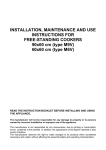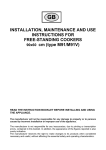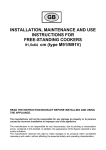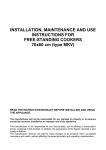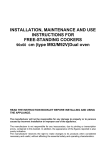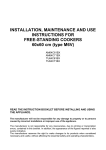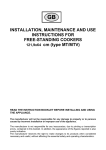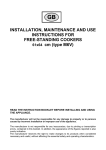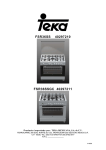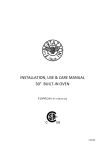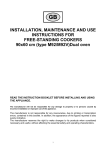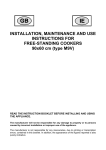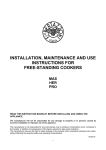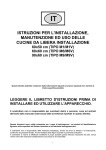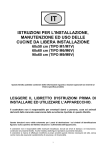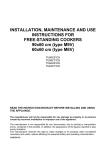Download La Germania TU6 4C 61 C X cooker
Transcript
INSTALLATION, MAINTENANCE AND USE INSTRUCTIONS FOR FREE-STANDING COOKERS 90x60 cm (type M9V) 60x60 cm (type M6V) READ THE INSTRUCTION BOOKLET BEFORE INSTALLING AND USING THE APPLIANCE. The manufacturer will not be responsible for any damage to property or to persons caused by incorrect installation or improper use of the appliance. The manufacturer is not responsible for any inaccuracies, due to printing or transcription errors, contained in this booklet. In addition, the appearance of the figures reported is also purely indicative. The manufacturer reserves the right to make changes to its products when considered necessary and useful, without affecting the essential safety and operating characteristics. CONTENTS: INSTALLER TECHNICAL MANUAL ............................................................................................................... pg. 2 Installing the cooker - Installation information ................................................................................................. pg. 2 Ventilation and aeration of rooms.................................................................................................................... pg. 2-3 Gas connection ............................................................................................................................................... pg. 3 Adaptation to different types of Gas and burner adjustments.......................................................................... pg. 3-4 Electric connection .......................................................................................................................................... pg. 4-5 Three-phase electric connection .................................................................................................................... pg. 5 APPLIANCE MAINTENANCE - Replacing parts ............................................................................................. pg. 5-6 USE AND MAINTENANCE MANUAL ............................................................................................................. pg. 6 Description of control panel and control types................................................................................................. pg. 6 Using burners .................................................................................................................................................. pg. 7 Use of the electric plates ................................................................................................................................ pg. 7-8 Using the ceramic hob ................................................................................................................................... pg. 8 Using the gas oven ........................................................................................................................................ pg. 8-9 Using the thermostat with switch in series....................................................................................................... pg. 9 Using the electric thermostat ........................................................................................................................... pg. 10 Using the 9+0 switch ....................................................................................................................................... pg. 10 Using the natural conventional electric oven .................................................................................................. pg. 10-11 Using the ventilated electric oven .................................................................................................................... pg. 11-12 Using the gas grill ............................................................................................................................................ pg. 12 Using the electric grill - ventilated electric grill ................................................................................................. pg. 12-13 Using the minute-minder ................................................................................................................................. pg. 13 Using the analogue clock with timer ................................................................................................................ pg. 14 3 keys electronic programmer ......................................................................................................................... pg. 14-15 Cleaning the appliance .................................................................................................................................... pg. 15-16 After-sales technical service and spare parts .................................................................................................. pg. 16 THIS APPLIANCE HAS BEEN DESIGNED FOR NON-PROFESSIONAL DOMESTIC USE. INSTALLER TECHNICAL MANUAL This appliance conforms with the regulations of European directive 2002/95/CE This appliance is marked according to the European directive 2002/96/EC on Waste Electrical and Electronic Equipment (WEEE). This guideline is the frame of a European-wide validity of return and recycling on Waste Electrical and Electronic Equipment. INSTALLER INFORMATION The installation, all adjustments, transformations and maintenance listed in this part of the manual must be carried out only by skilled personnel. Improper installation may cause damage to persons, animals or property, for which the manufacture will not be held responsible. The appliance safety or automatic adjustment devices may be changed during the service life of the system only by the manufacturer or by the duly authorised supplier. INSTALLING THE COOKER After having removed the various loose parts from the internal and external packing, make sure that the cooker is not damaged. In case of doubt, do not use the appliance and contact skilled personnel. Keep all the dangerous packing parts (polystyrene foam, bags, cardboard, staples, etc.) away from children. The appliance can be installed as a freestanding unit, next to a wall at a distance of no less than 20mm (Fig.2, Class 1 Installation) or inserted between two walls (Fig.1, Class 2 Subclass 1 Installation). A single sidewall that exceeds the height of the work surface is possible. This must be at a minimum distance of 70 mm from the edge of the cooker (Fig.2, Class 1 Installation) Any walls of the adjacent furniture pieces and the wall behind the cooker must be made with heat-resistant material that can withstand a minimum overtemperature of 65 K. The appliance can be installed as class 1 and as class 2 subclass 1. WARNING: when the appliance is installed as class 2 subclass 1, the connection to the gas network must only use metal flexible pipes that conform with the national standards in force. IMPORTANT INFORMATION FOR INSTALLING THE APPLIANCE The cooker can be installed separately, as a freestanding unit, or between kitchen units or between a kitchen unit and the wall. The device must be installed in accordance with the regulations stated in UNI 7129 and UNI 7131 standards. This appliance is not connected to devices which exhaust combustion products. Special attention must be focused on the prescriptions described below regarding room aeration and ventilation. Any hanging cabinets installed above the work surface must be located at a distance of no less than 700 mm. 2 ROOM VENTILATION To ensure that the appliance operate correctly, the room where it is installed must be continuously ventilated. The room volume should not be less than 25 m³ and the quantity of air needed shall be based on the regular combustion of gas and on the ventilation of the room. Natural air will flow through permanent openings in the walls of the room to be ventilated: these openings will be connected with the outside environment and shall have a minimum cross-section defined by the current national standards regarding room ventilation (see Fig. 3). These openings shall be built so that they cannot be clogged. Indirect ventilation is also permitted by taking air from the rooms adjacent to the one to be ventilated. LOCATION AND AERATION The gas cooking appliances must always evacuate the combustion products by means of hoods connected to chimneys, flues or directly outside (see Fig. 4). If a hood cannot be installed, it is possible to use a fan installed on a window or directly facing outdoors, to be operated together with the appliance (see Fig. 5), provided that there is strict compliance with the ventilation regulations. APPLIANCE GAS CONNECTION Before connecting the appliance to the gas network, make sure that the data on the label attached to the food warmer drawer or on the back of the cooker are compatible with what is indicated for the gas distribution network. A label attached to the last page of this handbook and in the food warmer drawer (or on the back) of the appliance indicates the appliance adjustment conditions: type of gas and operating pressure. IMPORTANT: This appliance must be installed in compliance with current national standards in force and used only in a well-ventilated room. WARNING: It should be recalled that the appliance utilises a threaded 1/2" gas cylindrical male fitting according to UNI-ISO 228-1. To connect the appliance to the gas network with a flexible rubber hose, a supplemental hose nipple fitting is needed (see Fig. 6) which is supplied with the appliance. ADAPTATION TO DIFFERENT TYPES OF GAS FOR COOKER TYPE M6V Before performing any maintenance operation, disconnect the appliance from the gas supply and electricity network. REPLACING THE NOZZLES TO OPERATE WITH ANOTHER TYPE OF GAS FOR COOKER TYPE M6V: Follow the instructions below to change the burner nozzles on the work surface: 1) Pull out the plug from the electric outlet to avoid any type of electric contact. 2) Remove the grids from the work surface (Fig. 7A-7B). 3) Remove the burners (Fig. 7A-7B). 4) Unscrew the nozzles using a 7 mm spanner, and replace them (Fig.8) with those needed for the new type of gas according to what is indicated in Table 1 for model M6 and in Table 2 for model M9 Follow the instructions below to change the oven burner nozzle: 1) Remove the oven level (Fig. 9A-9B). 2) Loosen the screw V and pull out the burner from the support being careful not to damage the ignition plug and the thermocouple (Fig. 10-11). 3) Unscrew the nozzle R (Fig. 10-11) using a 10 mm spanner (model M6) or a 7 mm spanner (model M9) and replace it with the nozzle needed for the new type of gas according to what is indicated in Table 1 for model M6 and in Table 2 for model M9. Follow the instructions below to change the grill burner nozzle: 1) Loosen the screw A and pull out the burner from the support being careful not to damage the ignition plug and the thermocouple (Fig. 12). 2) Unscrew the nozzle C (Fig. 12) using a 7 mm spanner and replace it with the nozzle needed for the new type of gas according to what is indicated in Table 1 for model M6 and in Table 2 for model M9. WARNING: After completing the above-mentioned replacements, the technician must adjust the burners, as described in the paragraph below, seal any adjustment and pre-adjustment devices and apply the label on the appliance, to replace the existing one, corresponding to the new gas adjustment. This label is contained in the spare nozzle bag. 3 TABLE N°1: Adaption to various types of gas Burner Types of Gas Natural G20 Auxiliary Butane G30 Propane G31 Natural G20 Semi-Rapid Butane G30 Propane G31 Natural G20 Rapid Butane G30 Propane G31 Double Natural G20 Ring Butane G30 Propane G31 Natural G20 Oven Butane G30 Propane G31 Natural G20 Grill Butane G30 Propane G31 Pressare Mbar 20 30 37 20 30 37 20 30 37 20 30 37 20 28 37 20 28 37 APPLIANCE CATEGORY: Nozzle Diameter 1/100 mm. 72 50 50 97 65 65 115 85 85 135 95 95 125 85 85 96 65 65 TABLE N°2: Adaption to various types of gas Burner Types of Gas Pressare Nozzle Diameter Mbar 1/100 mm. Natural G20 20 72 Auxiliary Butane G30 30 50 Propane G31 37 50 Natural G20 20 97 Semi-Rapid Butane G30 30 65 Propane G31 37 65 Natural G20 20 115 Rapid Butane G30 30 85 Propane G31 37 85 Double Natural G20 20 131 Ring Butane G30 30 95 Propane G31 37 95 Natural G20 20 150 Oven Butane G30 28 95 Propane G31 37 95 Natural G20 20 115 Grill Butane G30 28 68 Propane G31 37 68 Rater Capacity g/h 73 71 127 125 218 214 254 250 218 214 131 128 l/h 95 167 286 334 286 172 - kw 1 1 1 1,75 1,75 1,75 3 3 3 3,5 3,5 3,5 3 3 3 1,8 1,8 1,8 kcal/h 860 860 860 1505 1505 1505 2580 2580 2580 3010 3010 3010 2580 2580 2580 1548 1548 15480 APPLIANCE CATEGORY: II2H3+ Rater Capacity g/h 73 71 127 125 218 214 254 250 327 321 145 143 l/h 95 167 286 334 429 191 - kw 1 1 1 1,75 1,75 1,75 3 3 3 3,5 3,5 3,5 4,5 4,5 4,5 2 2 2 kcal/h 860 860 860 1505 1505 1505 2580 2580 2580 3010 3010 3010 3870 3870 3870 1720 1720 1720 II2H3+ Reduced Capacity kw Kcal/h 0,48 413 0,48 413 0,48 413 0,6 516 0,6 516 0,6 516 1,05 903 1,05 903 1,05 903 1,8 1548 1,8 1548 1,8 1548 1 860 1 860 1 860 - by-pass Diameter Reduced Capacity kw Kcal/h 0,48 413 0,48 413 0,48 413 0,6 516 0,6 516 0,6 516 1,05 903 1,05 903 1,05 903 1,8 1548 1,8 1548 1,8 1548 2 1720 2 1720 2 1720 - by-pass Diameter 1/100 mm. 34 34 34 36 36 36 52 52 52 65 65 65 42 42 42 NO by-pass 1/100 mm. 34 34 34 36 36 36 52 52 52 65 65 65 70 70 70 NO by-pass BURNER ADJUSTMENT 1)Primary air adjustment: Oven burner adjustment: follow the instructions below to adjust the primary air for the over burner: 1) Remove the oven bottom. 2) Loosen the screw P and adjust the position X of the Venturi cone (Fig. 12) according to the measurements indicated in table 3. Grill burner adjustment: to adjust the grill burner loosen screw P and adjust the position X of the Venturi cone (Fig. 13) according to the measurements indicated in table 3. TABLE N°3: Burner primary air regulation (indicative) Type of gas Natural Butane Propane G20 G30 G31 BURNER Oven (mm) Grill (mm) M6 M6 fully open fully open fully open fully open fully open fully open 2) Burner "MINIMUM" adjustment: Work surface burner adjustment: follow the instructions below to adjust the work surface burner minimum: 1) Light the burner and set the knob to the MINIMUM position (small flame). 2) Remove the knob of the valve that is press fit on the rod of that valve. 3) If the cooker is not equipped with safety valves on the surface burners, insert a small slotted screwdriver into the hole on the valve rod (Fig. 14) and turn the choke screw to the right or left until the burner flame is adjusted to minimum. If the cooker is equipped with safety valves, the choke valve is not located in the rod hole, but on the valve body (see fig. 15). 4 4) Make sure that the flame does not go out when switching quickly from the MAXIMUM to the MINIMUM position. Oven burner adjustment: follow the instructions below to adjust the minimum: 1) Light the burner setting the knob to the MAXIMUM position. 2) Close the oven door and operate the oven for at least 10 minutes. 3) Set the knob to the MINIMUM position (corresponding to 120°) and then remove it. 4) With a slotted screwdriver turn the choking screw (see figure 16) and, while observing the flame at the same time through the cooker porthole, evaluate the consistency of the flame so it remains on when switching quickly from the MINIMUM to the MAXIMUM position. WARNING: The above-mentioned adjustment should be made only with methane gas burners, while for those operating with liquid gas the screw must be locked at the end in a clockwise direction. The grill burner always operates at maximum and therefore no minimum adjustment is required. APPLIANCE ELECTRIC CONNECTION: The electric connection must comply with the current legal standards and regulations. Before making the connection, check that: - The system electrical rating and the current outlets are adequate for the maximum power output of the appliance (see the label applied to the bottom of the casing). - The outlet or the system is equipped with an efficient ground connection in accordance with the current legal standards and regulations. The company will not be responsible for the non-compliance with these instructions. When the connection to the power supply network is made using an outlet: - If the power cord is supplied without a plug, apply a standard plug that is suitable for the load indicated on the label. Connect the wires according to the diagram shown in FIG.17 and check that: letter L (phase) = brown wire; letter N (neutral) = blue wire; = green-yellow wire; ground symbol - The power cord must be positioned so that an overtemperature of 75 K will not be reached at any point. - Do not use reductions, adapters or splitters since they might cause false contacts and lead to dangerous overheating. When the connection is made directly to the electric network: - Use a device that ensures disconnection from the mains in which the contacts are opened to a distance that permits complete disconnection according to the conditions for over-voltage category III. - Remember that the ground wire must not be interrupted by the circuit-breaker. - As an alternative, the electric connection can also be protected by a high-sensitivity residual current circuit-breaker. - It is highly recommended to attach the special green-yellow ground wire to an efficient ground system. WARNING: If the power cord is replaced, the ground wire (yellow-green) connected to the terminal, should be longer than the other wires by about 2 cm. TABLE N°4 : TYPES OF POWER CORDS Work surface operation Oven operation Only gas burner Gas oven / Gas grill Gas oven / Electric grill Electric Oven Gas burner + 1 hot plate Ventilated Electric Oven Gas oven / Gas grill Gas oven / Electric grill 230V ~ 3x0.75mm² 3x1mm² 3x1mm² (M6) 3x1,5mm² (M9 3x1,5mm² 3x1mm² 3x1,5mm² (M6) 3x2,5mm² (M9 3x1,5mm² (M6) 3x2,5mm² (M9 3x2,5mm² 3x2,5mm² 3x2,5mm² 3x2,5mm² 3x2,5mm² 3x2,5mm² 3x4mm² Electric Oven Gas burner + 2 hot plate 4 hot plate Ceran Ventilated Electric Oven Forno elettrico statico Forno elettrico ventilato multi-9 Forno elettrico statico Forno elettrico ventilato multi-9 Forno elettrico statico Forno elettrico ventilato multi-9 Cross section 230V 3~ 400V 2N~ 400V 3N~ - - - - - - - - - 4x1,5mm² 4x1,5mm² 4x1,5mm² 4x1,5mm² 4x1,5mm² 4x1,5mm² 4x1,5mm² 4x1,5mm² 4x1,5mm² 4x1,5mm² 4x1,5mm² 4x1,5mm² 5x1,5mm² 5x1,5mm² 5x1,5mm² 5x1,5mm² 5x1,5mm² 5x1,5mm² ATTENTION: The appliance conforms with the regulations of directives 90/396EEC (Gas Directive) regarding gas appliances for domestic use and the like, 93/68 and 73/23 (Low Voltage Directive) regarding electrical safety and 2004/108/CE, 93/68 and 89/336 (EMC Directive) regarding electromagnetic compatibility. THREE-PHASE ELECTRIC CONNECTION The cookers that can also be connected to three-phase systems normally are factory built for the single-phase 230V connection and are supplied with a power cord. Based on the connection system used, install the power cord type indicated in table No.4. To use the selected connection system change the jumpers on the terminal strip as indicated in the diagram of Fig.18 5 APPLIANCE MAINTENANCE ATTENTION: IMPORTANT WARNINGS For cookers resting on a base ATTENTION: If the cooker rests on a base, take the measures necessary to prevent the cooker from sliding along the support base. For cookers with glass covers ATTENTION: Before opening the appliance’s glass cover, carefully remove all liquid residues from the top of it. ATTENTION: Before closing the appliance’s glass cover, make sure that the work surface has cooled. For cookers with electric ovens The unit becomes hot during use. Do not touch the heating elements inside the oven. For cookers with electric ovens ATTENTION: The accessible parts can become hot during use. Keep children away from the appliance. For the food warmer compartment (or drop leaf in our case) ATTENTION: The internal parts of the food warmer can become hot during use. For glass doors Do not use abrasive cleaning products or metal spatulas with sharp edges to clean the oven door’s glass since this could scratch the surface and the glass could break. Do not use steam cleaners to clean the appliance. DOOR GUARD The M9 and M9V cookers with strips of stainless steel on the oven door can be equipped with a protective grating that can be installed on the door. Such grating is available on the service post sale (see Fig.43). REPLACING PARTS Before performing any maintenance operation, disconnect the appliance from the gas supply and electricity network. To replace parts such as knobs and burners, just remove them from the seats without disassembling any part of the cooker. To replace parts such as nozzle supports, valves and electric components follow the procedure described in the burner adjustment paragraph. To replace the valve or the gas thermostat, it is also necessary to disassemble the two rear gas train brackets, loosening the 4 screws (2 per bracket) that attach it to the rest of the cooker and, unscrew the nuts that attach the front burner valves to the control support, after removing all the knobs. To replace the gas or electric thermostat, also disassemble the rear cooker guard, loosening the relative screws, to be able to pull out and reposition the thermostat bulb. To replace the oven bulb, just unscrew the protection cap that projects out inside the oven. (Fig.19) WARNING: Before replacing the bulb, disconnect the appliance from the electric power supply. WARNING: The power cord supplied with the appliance is connected to that appliance with an X type connection (in compliance with standards EN 60335-1, EN 60335-2-6 and subsequent amendments) for which it can be installed without the use of special tools, with the same type of cord as the one installed. If the power cord becomes worn or damaged, replace it based on the information reported in table 4 . WARNING: If the power cord is replaced, the installer shall ensure that the ground cable is longer than the phase cables and also shall comply with the warnings regarding the electric connection. Greasing the valves: If it becomes difficult to operate the valve, it should be greased immediately by following the instructions listed below: 1) Disassemble the valve body by loosening the two screws located on the body of the valve.(Fig.20) 2) Extract and clean the seal cone and its housing with a rag soaked with thinner. 3) Lightly grease the cone with a special grease. 4) Insert the cone, moving it several times, remove it again, remove the excess grease and make sure that the gas passage ways are unobstructed. 5) Replace all the pieces by reversing the order in which they were disassembled and check that the valve operates correctly. 6)To replace the power cable, lift the terminal board’s cover and replace the cable. To access the terminal board in cookers with a 3x2.5mm² cable, the back panel on the rear of the appliance must be removed. USE AND MAINTENANCE MANUAL GAS BURNER DIMENSION Burner Auxiliary Semi-rapid Rapid Fish Ultra-rapid Dimension (mm) Ø 50 Ø 70 Ø 95 55x230 Ø 130 6 CERAN AND ELECTRIC HOT PLATE DIMENSION TIPE OF PLATE DIMENSION Electric hot plate Ø 145 Electric hot plate Ø 180 Electric hot plate infrared Ø 145 left rear 1200W Electric hot plate infrared Ø 145 right rear 2100W Electric hot plate infrared Ø 145 right front 1200W Electric hot plate infrared Ø 180 left front 1700W Electric hot plate hi light Ø 145 left rear 1200W Electric hot plate hi light Ø 170/265 left rear 1400/2200W Electric hot plate hi light Ø 145 left rear 1200W Electric hot plate hi light Ø 180 left rear 700/2100W CONTROL PANEL DESCRIPTION On the control panel, small symbols show the function of each knob or key. Here as follows are the several controls that a cooker can have: the symbol shows the disposition of burners on the worktop, the full dot identifies the burner in object (in this case the rear burner on the right). the symbol positions switch) shows the running of any oven (gas oven with gas grill, gas oven with electric grill, static oven, 9 the symbol shows the electric thermostat for electric fan oven the symbol shows the minute minder the symbol shows the operating key for the rotisserie (only gas oven) the symbol shows the oven fan working button as to allow the oven to operates with fan assisted gas. The fan operation of the oven prevents the operation of the electric grill, which therefore cannot be used with the fan in action. the symbol shows the ignition key for the oven light (all except the electric fan oven) the symbol shows the push-button for burner ignition the symbol shows if keys are in position “on” or “off” USING BURNERS A diagram is etched on the control panel above each knob which indicates which burner corresponds to that knob. The burners can be ignited in different ways depending on the type of appliance and its specific characteristics: - Manual lighting (it is always possible even when the power is cut off): Turn the knob anticlockwise that corresponds to the burner selected, setting it to the MAXIMUM position at the etched star (large flame Fig.23A-23B-23C) and place a lit match up to the burner. - Electric ignition: Turn the knob counterclockwise that corresponds to the burner selected, setting it to the MAXIMUM position (large flame Fig. 23A-23B-23C) and keep on pressing the knob in correspondence of the ignition symbol marked with a star (for cookers equipped with ignition trough knob) or press the ignition button marked with a star and release it as soon as the burner has ignited. - Burner ignition equipped with safety device (thermocouple)(fig.22): Turn the knob anticlockwise that corresponds to the burner selected, setting it to the MAXIMUM position at the etched star (large flame Fig. 23A-23B-23C), press the knob and activate one of the above-mentioned ignition devices. Once ignited, keep pressing the knob for about 10 seconds to allow the flame to heat the thermocouple. If the burner goes out after releasing the knob, repeat the entire operation. Note: It is recommended not to try to ignite a burner if the relative flame cap is not in the correct position. Tips for using burners correctly: - Use suitable pots for each burner (see tab. 5 and Fig. 21). - When the liquid is boiling, turn the knob to the MINIMUM position (small flame Fig. 23A-23B-23C). - Always use pots with a cover. 7 TABLE N°5 BURNER Auxiliary Semi-rapid Rapid Double ring PAN DIAMETER recommended (cm) 12-14 14-26 18-26 22-26 ATTENTION: Use pots with a flat bottom WARNING: If the power is cut off, the burners can be lit with matches. When cooking foods with oil and fat, which are very flammable, the user should not leave the appliance unattended. If the appliance is equipped with a glass cover, such a cover may break when heated. Turn off all burners before lowering the cover. Do not use sprays near the appliance when it is being used. When using the burners, make sure that the handles of the pots are correctly positioned. Keep children away from the appliance. If equipped with a cover, before being closed, any food deposits should be cleaned off the built-in surface. NOTE: The use of a gas cooking appliance produces heat and humidity in the room where it is installed. Therefore, proper aeration in the room is needed while ensuring that natural ventilation openings remain unobstructed (Fig.3) and activating the mechanical aeration device/exhaust hood or electric fan (Fig. 4 and Fig. 5). Intensive and continuous use of the appliance may require additional aeration, for example by opening a window, or more efficient aeration by increasing the power of the mechanical exhauster, if installed. USE OF THE ELECTRIC PLATES The plates are controlled by a switch with 6 positions ( Fig. 24A-24B ). The plates can be inserted by rotating the knob onto the desired position. On the front of the appliance there is a design showing which plate the knob refers to. The insertion of the plate is shown by the indicator light which is also found on the front panel of the appliance. How to use an electric plate: When you use the plate for the first time or after a long period over which the plate has not been used, you are advised to use the plate on position 1 for about 30 minutes in order to eliminate any humidity absorbed by the isolating material inside. As an indication we give a table with the necessary rules to follow for the best use of the electric plates. WARNING: When using the plate for the first time or after a long period over which the plate has not been used, in order to eliminate any humidity absorbed by the isolating material it is necessary to use the plate for about 30 minutes on position 1 of the switch. PLATE 1500W Watt COOKING POSSIBILITIES 0 0 Plate switched off 1 135 To melt butter, chocolate etc. - To heat up small quantities of liquid 2 165 To heat up larger quantities of liquid - to prepare creams/sauces with long cooking times 3 250 To thaw foods, cooking boiling temperatures 4 500 To cook roasts of delicate meat and fish 5 750 For roast of chops and steaks, for large boiled foods 6 1500 To boil large quantities of water, to fry For a correct use remember the following: - Dry the bottom of the pan before putting it on the plate. - Use pans with a flat bottom and in thick metal ( see Fig. 25 ). - Never use pans which are smaller than the plate. - Switch on the current after you have put the pan on the plate. - After use, to keep the plate in good condition, always treat the plate with normal products for electric plates which are available on the market so that the surface is always clean; doing this will avoid any eventual oxidisation (rust). - Even after use the plates stay hot for a long time and so do not put your hands or other objects on the plates so as to prevent possible burns. - When the plates are in use make sure that the pan handles are positioned correctly. Keep children away. – When cooking foods with oil and fat, which can easily set alight, the user must not leave the appliance. WARNING: As soon as you see a crack in the surface of the plate immediately disconnect the appliance from the mains. USING THE CERAMIC HOB The work surface fas 4 cooking areas with different heating levels and diameters. The position are clearly indicated by circular areas that are not etched. Heating takes place within these marked areas. If 1 or 2 cooking areas are used, the other surface remain cold. It is recommended to use special utensil for electric cooking to ensure efficient use and to save energy. The bottom of the surface should be thick and flat to guarantee the best cooking. The diameter of the base of the pots (or other containers) should be as close as possible to the diameter of the plate being used, if it is smaller, the energy will be wasted since the heat generated will be partially dispersed by the uncovered surface of the plate. The surface of the hob and the base of the container must be clean following these hints will save energy and heat. How to use the ceramic hob. Each cooking area is controlled by a thermostat or by an energy regulator that is used to select a variable temperature. When the boiling point is reached, the temperature can be reduced allow the food to slow boil. Practice will indicate the 8 right time to allow the foods to slow boil, but obviously this depends on the food and the type of pot. The correct combination will save time and energy. WARNING: Your CERAN ceramic hob is resistant to thermal shocks and is not unaffected by heat or cold. Accidental impacts with a heavy casserole dish will not damage the hob. However, a special type of impact, causer by a heavy abject such as a salt container or a spice bottle on the edge or corner of the hob, may break the surface. USING THE GAS OVEN GAS OVEN: All the gas oven cookers are equipped with a thermostat and safety device to adjust the cooking temperature. The oven temperature is set by turning the knob counterclockwise to match the indicator with the temperature selected. The gas oven can be combined with a gas grill or an electric grill. See the specific pages for use information. FAN GAS OVEN: Operating the fan of the oven by means of the appropriate switch situated on the control panel, the circulation of warm air guarantees a uniform heat distribution. The preheating of the oven can be avoided. However for delicate baking, it is preferable to warm the oven before introducing the baking-pan. The baking system with the fan convection changes in part the various traditional baking notions. When roasting meat it is not necessary to turn the meat any more and for a roast on the spit, it is not indispensable to use the spit-roaster, but is sufficient to put the meat directly on the grate. With the use of the fan gas oven, the baking temperatures are slightly lower of about 10-15°C compared to those in use with the traditional gas oven. The fan operation of the oven prevents the operation of the electric grill, which therefore cannot be used with the fan in action. The oven can also be used in a traditional way, (by not activating the fan) for foods requiring heat from the bottom, e.g. pizza. WARNING: If the burner flames are extinguished accidentally, turn off the control knob and do not try to relight the oven until after at least 1 minute. TABLE N°6 THERMOSTAT SETTING 1 2 3 4 5 6 7 8 TEMPERATURE °C 120°C 140°C 160°C 180°C 200°C 225°C 245°C 270°C The oven burner can be ignited in different ways: - Manual lighting (it is always possible even when the power is cut off): To light the oven, open the oven door and turn the knob so the no. 8 on the scale matches the indicator (fig.26A-26B26C-26D). At the same time put a lit match next to the ignition tube that is visible on the oven level (fig.27A for cooker type M6V)(fig.27B for cooker type M9V). Then press the thermostat knob (this makes the gas start to flow) and keep it pressed, after the burner has been completely lit, for 10 seconds. Release the knob and make sure that the burner remains on, otherwise repeat the operation. - Electric ignition (only for the models equipped with this device): In this case, first open the oven door, then turn the knob to the maximum temperature setting (number 8). Then press the thermostat knob (models with ignition trough knob). Wait about 10 seconds after the burner has been completely lit and then release the knob. Make sure that the burner remains on, otherwise repeat the operation. As for cookers without ignition trough knob, press the thermostat knob and the key with the spark symbol, wait about 10 seconds after the burner has been completely lit and then release the knob. Make sure that the burner remains on, otherwise repeat the operation. The ignition device should not be used for more than 15 seconds. If after that period the burner still has not been lit, do not use the device and open the door of the room or wait at least 60 seconds before trying to light the oven again. WARNING: when trying to light the oven, the door must always be open. When using the oven, leave the cooker cover open to prevent it from overheating. NOTICE: when using the oven for the first time it should be operated for 15-30 minutes at a temperature of about 250° without cooking anything inside in order to eliminate any moisture and odours from the internal insulation. During normal oven use, after lighting the burner and setting the desired temperature, wait about 15 minutes before putting in any food to preheat the oven. The oven is equipped with 5 guides at different heights level (fig.28) which can be used to insert shelves or the tray. To keep the oven as clean as possible it is recommended to cook meat on the tray or on the shelf that has been inserted inside the tray. The table below lists the general cooking times and the position of the tray for different types of foods. Personal experience will help to determine any variations in the values reported in the table. In any case, it is recommended to follow the instructions of the specific recipe being used. Temperatures between brackets are referred to the use of oven with fan assisted gas. 9 TABLE N°8 GAS OVEN COOKING TABLE TEMP °C MEAT PORK ROAST BEEF ROAST (YOUNG STEER) BEEF ROAST VEAL ROAST LAMB ROAST ROAST BEEF ROAST HARE ROAST RABBIT ROAST TURKEY ROAST GOOSE ROAST DUCK ROAST CHICKEN FISH 220 250 240 220 220 230 235 220 235 225 235 235 (210) (240) (230) (210) (210) (230) (225) (210) (225) (215) (225) (225) 200-225 (190-215) PASTRY FRUIT PIE TEA CAKE BRIOCHES SPONGE CAKE RING CAKE SWEET PUFF PASTRIES RAISIN LOAF STRUDEL SAVOIA COOKIES APPLE FRITTERS SAZOIARDI SANDWICH TOAST SANDWICH BREAD PIZZA 200 190 175 235 190 220 220 180 190 220 220 250 220 220 (210) (180) (165) (225) (180) (210) (210) (170) (180) (210) (210) (240) (210) (210) HEIGHT MINUTES 4 4 4 4 4 4 4 4 4 4 4 4 60-70 50-60 60-70 60-70 45-55 55-65 40-50 50-60 50-60 60-70 45-60 40-45 3 15-25 3 3 3 3 3 3 3 3 3 3 3 4 3 3 35-40 50-55 25-30 20 30-40 20 15-20 15-20 15 20 20-30 5 30 20 USING THE THERMOSTAT WITH SWITCH IN SERIES (COOKERS WITH A SINGLE-CONTROL CONVENTIONAL ELECTRIC OVEN) The electric oven is controlled by an electric thermostat combined with a switch used to turn on the elements. The electric oven can be combined with an electric grill. The oven is heated by 2 elements: one on the top and one on the bottom. Turning the knob (fig.29) turns on the bottom element and the top external elements while the thermostat is used to set the temperature ranging from 50°C to 250°C. It can be adjusted using the scale indicated on the ring around the knob. An orange light turns off indicating that the temperature setting has been reached. Therefore, it is normal for this light to turn on and off while the oven is working. There are 3 fixed position beyond the 250°C setting: - the symbol or indicates the only the bottom element (1300W M6; 1800 W M9) has been turned on; or indicates that only the top external element (900W M6; 1200 W M9) has been turned on; - the symbol - the symbol or indicates that only the grill element (1500W M6; 1800W M9) has been turned on; In these positions the temperature is not controlled by the thermostat. Warning! Oven light running for static oven. As for cookers with one control electric static oven, the oven lamp can be switched on thanks to the specific button and also every time that the oven is ignited trought the relative selector. USING THE ELECTRIC THERMOSTAT The thermostat supplied with the relative models maintains a constant temperature inside the oven at a specific temperature setting ranging from 50°C to 250°C.(fig.30A-30B-30C) Turn the knob clockwise and align the selected temperature indicated on the ring with the index etched on the control panel. Thermostat operation is indicated by an orange light which will turn off when the temperature inside the oven is 10°C greater than the temperature setting, and will turn on when the oven is 10°C less than the temperature setting. The thermostat can control the oven elements only if the relative switch is in one of the possible oven element operating modes: if the switch is in position 0, the thermostat has not effect on the oven elements, which remain off. USING THE 9 + 0 SWITCH (fig.31A-31B-31C) The 9 + 0 switch installed in the multifunction oven models is used, along with the thermostat, to control the electric fan and the oven elements since they can be turned on by turning the 9 + 0 switch knob and the thermostat knob. Turning just one of the two knobs will not have any effect on the oven except to turn on the oven light or the electric fan when inserted. The electric oven is heated by 4 elements: one on the bottom, two on the top or one circular; turning the switch knob turns on the element relative to the symbol indicated on the ring but to be activated the thermostat knob must be turned until the orange light turns on indicating that the element has been turned on. Placing the switch knob on any of the nine operating modes turns on the oven light, together with the relative element. Once the temperature and the elements to be used have been set, the oven elements are turned on and off by the thermostat; therefore, it is normal for the orange light to turn on and off while the oven is working. 10 To turn off the electric oven set the switch knob to position 0 to prevent the thermostat from controlling the elements. Setting the thermostat knob to position 0 turns off the elements but it is still possible, using the switch, to turn on the electric fan and the oven light. The switch has 9 different fixed positions corresponding to 9 different types of oven operation: For type M6V or indicates that only the oven light is turned on; - the symbol or indicates that the bottom element (1300W) and the top external element (900W) have been turned - the symbol on; or indicates that only the top external element (900W) has been turned on; - the symbol or indicates the only the bottom element (1300W) has been turned on; - the symbol - the symbol or indicates that only the grill element (2000W) has been turned on; - the symbol or indicates that the top external element (900W) and the grill element (2000W) have been turned on; - the symbol or indicates that the top external element (900W), the grill element (2000W) and the electric fan have been turned on; or indicates that the circular element (2400W) and the electric fan have been turned on; - the symbol or indicates that only the electric fan has been turned on. - the symbol For type M9V or indicates that only the oven light is turned on; - the symbol or indicates that the bottom element (1800W)and the top external element (1200W) have been turned - the symbol on; - the symbol or indicates that only the top external element (1200W) has been turned on; - the symbol or indicates the only the bottom element (1800W) has been turned on; or indicates that only the grill element (18000W) has been turned on; - the symbol - the symbol or indicates that the top external element (1200W) and the grill element (1800W) have been turned on; or indicates that the top external element (1200W), the grill element (1800W) and the electric fan - the symbol have been turned on; - the symbol or indicates that the circular element (3000W) and the electric fan have been turned on; - the symbol or indicates that only the electric fan has been turned on. When the knob is set to one of these nine positions, the oven light is always on, thus indicating that the oven is being energised. USING THE NATURAL CONVENTIONAL ELECTRIC OVEN When using the oven for the first time it should be operated for a maximum of 30 minutes at a temperature of about 250° to eliminate any odours generated by the internal insulation. During normal oven use, select the desired cooking temperature using the thermostat knob and wait until the orange light turns off before putting in any food. The oven is equipped with 5 guides at different heights (fig.28) which can be used to insert shelves or the tray. To keep the oven as clean as possible it is recommended to cook meat on the tray or on the shelf that has been inserted inside the tray. Table No. 8 below lists the cooking times and the position of the tray for different types of foods. Personal experience will help to determine any variations in the values reported in the table. In any case, it is recommended to follow the instructions of the specific recipe being used. TABLE N°8 NATURAL CONVENTIONAL ELECTRIC OVEN COOKING TABLE TEMP °C MEAT PORK ROAST 225 BEEF ROAST (YOUNG STEER) 225 BEEF ROAST 250 VEAL ROAST 225 LAMB ROAST 225 ROAST BEEF 230 ROAST HARE 250 ROAST RABBIT 250 ROAST TURKEY 250 ROAST GOOSE 225 ROAST DUCK 250 ROAST CHICKEN 250 FISH 200-225 11 HEIGHT MINUTES 4/5 4/5 4/5 4/5 4 4/5 4/5 4 4 4 4/5 4/5 60-80 60-80 50-60 60-80 40-50 50-60 40-50 60-80 50-60 60-70 45-60 40-45 3 15-25 PASTRY FRUIT PIE TEA CAKE BRIOCHES SPONGE CAKE RING CAKE SWEET PUFF PASTRIES RAISIN LOAF STRUDEL SAVOIA COOKIES APPLE FRITTERS SAZOIARDI SANDWICH TOAST SANDWICH BREAD PIZZA 225 175-200 175-200 220-250 180-200 200-220 250 180 180-200 200-220 200-220 250 220 220 3 3 3 3 3 3 3 3 3 3 3 4 4 3 35-40 50-55 25-30 20-30 30-40 15-20 25-35 20-30 40-50 15-20 20-30 5 30 20 USING THE VENTILATED ELECTRIC OVEN When using the oven for the first time it should be operated for a maximum of 30 minutes at a temperature of about 250° to eliminate any odours generated by the internal insulation. Before cooking, allow the oven to reach the desired temperature setting waiting for the orange light to turn off. This type of oven is equipped with a circular element around which a fan has been installed that creates forced-air circulation in the horizontal direction. Thanks to this type of operation, the ventilated oven can be used for different types of cooking at the same time, without changing the taste of each food. Only some models are equipped with a removable metallic filter applied to the rear screen which collects the fat while a roast is cooking. Therefore, it is recommended to remove this fat periodically, washing the screen with soapy water and rinsing thoroughly. To remove the metallic filter just apply slight pressure toward the top on the tab indicated by the arrow. Hot-air circulation guarantees a uniform distribution of heat. Pre-heating the oven is not necessary, but for very delicate pastries, it is recommended to heat the oven before inserting the trays. The ventilated conventional system partially changes the various notions about traditional cooking. Meat no longer needs to be turned while it is cooking and the rotisserie is no longer needed to cook a roast on the spit. Just put the meat directly on the shelf. TABLE N°9 VENTILATED ELECTRIC OVEN COOKING TABLE TEMP °C HEIGHT MINUTES MEAT PORK ROAST BEEF ROAST (YOUNG STEER) BEEF ROAST VEAL ROAST LAMB ROAST ROAST BEEF ROAST HARE ROAST RABBIT ROAST TURKEY ROAST GOOSE ROAST DUCK ROAST CHICKEN 160-170 170-180 170-190 160-180 140-160 180-190 170-180 160-170 160-170 160-180 170-180 180 3 3 3 3 3 3 3 3 3 3 3 3 70-100 65-90 40-60 65-90 100-130 40-45 30-40 80-100 160-240 120-160 100-160 70-90 FISH 160-180 3/4 PASTRY FRUIT PIE TEA CAKE BRIOCHES SPONGE CAKE RING CAKE SWEET PUFF PASTRIES RAISIN LOAF STRUDEL SAVOIA COOKIES APPLE FRITTERS SAZOIARDI SANDWICH TOAST SANDWICH BREAD PIZZA 180-200 200-220 170-180 200-230 160-180 180-200 230-250 160 150-180 180-200 170-180 230-250 200-220 200-220 3 3 3 3 3 3 3 3 3 3 3 4 4 3 12 40-50 40-45 40-60 25-35 35-45 20-30 30-40 25-35 50-60 18-25 30-40 7 40 20 USING THE GAS GRILL The gas grill can be combined only with the gas oven. It is controlled with the same gas oven knob (fig. 26A-26B-26C26D), but turning it clockwise instead of counterclockwise (see the gas oven use instructions), matching the symbol with the indicator. The grill burner always operates at maximum and therefore there is no minimum position. In addition, it is equipped with a safety device to prevent the flame from going out. The gas grill can also be ignited in different ways: - Manual lighting: Just completely open the oven door, turn the knob so that the relative symbol matches the indicator, while pressing the knob, and, at the same time, put a lit match next to the burner. Make sure that the burner is completely lit and after about 10 seconds release the knob. Make sure that the burner remains on, otherwise repeat the operation. - Electric ignition: In this case, completely open the oven door, turn the knob so that the relative symbol matches the indicator, then press the thermostat knob (models with ignition trough knob). Wait about 10 seconds after the burner has been completely lit and then release the knob. Make sure that the burner remains on, otherwise repeat the operation. As for cookers without ignition trough knob, press the thermostat knob and the key with the spark symbol, wait about 10 seconds after the burner has been completely lit and then release the knob. Make sure that the burner remains on, otherwise repeat the operation. WARNING: As with the oven, the grill must be lit with the door completely open. The gas grill can be used to grill foods on the oven shelf or using the rotisserie. Grilling on the shelf: In this case, the shelf supplied is placed on level 1 or 2 and the foods to be grilled are placed on top, while the tray is inserted on the lower levels to collect the cooking juices. Then light the grill burner according to the instructions described above. IMPORTANT: grill foods on the shelf always with the door semi-open (fig. 35) and, to avoid overheating, mount the handle guard on the relative latches (fig. 32). Grilling with the rotisserie: This is used to grill with the rotating skewer. Therefore, insert the skewer holder on the side shelves at level 3. Insert the food on the skewer and insert everything into the oven, inserting the point of the skewer into the spindle that projects out from the rear or left size of the oven and resting the front of the skewer into the skewer holder support (Fig. 33 for cooker type M6V) (Fig. 34 for cooker type M9V). Then, insert the tray into one of the lower guides and press the button that starts the rotisserie. Then light the grill burner according to the instructions described above. IMPORTANT: grill foods with the rotisserie always with the door open (fig. 36 ) for cooker type M6V and with the door semi-open (fig. 35) for cooker type M9V and, to avoid overheating, mount the handle guard on the relative latches (fig. 32). WARNING: the accessible parts may become very hot while grilling. Keep children away from the appliance while cooking. USING THE CONVENTIONAL ELECTRIC GRILL The electric grill can also be combined with the gas oven or electric oven. In both cases, the grill is controlled using the oven’s temperature knob (see also, Using the gas or electric oven). Like the gas grill, the electric grill can be used for grilling on the oven’s grill or using the roasting spit. The static electric grill must be used with the door closed. The temperature set on the thermostat (when present) must not exceed 150°C. The power of the electric grill for M6 cookers with gas oven is 1500W whereas for M9 cookers with gas oven it is 1800W. Grilling on the shelf: In this case, the shelf supplied is placed on level 1 or 2 and the foods to be grilled are placed on top, while the tray is inserted on the lower levels to collect the cooking juices. Then turn on the grill element switching the thermostat to the relative position (electric oven version). Grilling with the rotisserie: This is used to grill with the rotating skewer. Therefore, insert the skewer holder on the side shelves at level 3. Insert the food on the skewer and insert everything into the oven, inserting the point of the skewer into the spindle that projects out from the rear or left size of the oven and resting the front of the skewer into the skewer holder support. Then, insert the tray into one of the lower guides and switch the thermostat to the relative position and press the button with the rotisserie symbol (electric oven version). WARNING: the accessible parts may become very hot while grilling. Keep children away from the appliance while cooking. USING THE VENTILATED ELECTRIC GRILL The ventilated electric grill is a special function equipped only on the multifunction oven. Set the 9 + 0 switch to the relative position to activate the grill element (2900W) and the electric fan. Generally, to ensure excellent grilling, place the oven shelf in the middle position while the oven tray should be inserted at the bottom. IMPORTANT: When using the ventilated electric grill, set the thermostat knob no higher than 175 °C, which is between the 150 °C and 200 °C setting, to avoid overheating the front of the appliance. In fact, ventilated grilling must be carried out with the door closed. USING THE MINUTE-MINDER (fig.37A-37B-37C) The minute-minder advises the user, with an acoustic signal, when food has been cooked, after a certain time period has elapsed. To use the device, wind the minute-minder by turning the knob clockwise one complete turn. Then turn the knob counterclockwise so that the indicator corresponds with the selected cooking time. WARNING: the acoustic signal does not stop the cooking cycle. The use must turn off the cooking cycle by hand using the relative knobs. 13 ANALOGUE CLOCK WITH TIMER (fig. 38) The analogue clock with timer lets you know when the cooking is finished thanks to an acoustic signal. To set the clock, push and contemporarily turn the pivot clockwise until you reach the chosen time; let the pivot, then turn it clockwise again (without pushing) until the ring is positioned on the crossed bell: in this way only the clock will be functioning. To use the timer, turn the pivot clockwise without pushing and choose, using the ring, the cooking time; once the time is over, the clock will alert you with an acoustic signal. PLEASE NOTICE that the acoustic signal does not interrupt the cooking process. To stop it, it is necessary to switch off manually the corresponding buttons. 3 KEYS ELECTRONIC PROGRAMMER(fig. 39) The first start up The numbers and the A letter on the display are blinking when the oven is switched on for the first time, or after a power cut: the appliance cannot be operated in this condition. To set the hour and/or to enable the appliance to operate press the M key for at least 2 seconds: the A letter turns off and the numbers now are steady on the display. The dot (3) starts blinking: press the - or + key to set the hour. The hour is accepted by the programmer just few second after having released the key. N.B. the appliance can be correctly used for coking only when you will see on the display the symbol (2). The symbols on the display: 1 A* Automatic programme is working. (* in some models there is the writinq 'Auto' instead of A). 2 3 The appliance is ready for manual use (not automatic). • 4 5 When blinking, the programmer is in setting hour mode. Timer set. - Decreasing numbers when setting the timer. Also for choose your desired sound level ( 3 levels available). 6 7 M + "Mode" kev to access the programming options of the programme. Increasing numbers when setting the timer. Timer The purpose of the timer is just of a sound signal, which can be set for a max time of 23h59min. once elapsed the set time, the (4) symbol turns off and a sound signal is heard; this sound set off automatically in 7min, or you can stop it by pressing any key of the programmer. To set the timer press the M key for 2 seconds, or anyway just to see the (4) symbol blinking. Set the timer by using the + or - keys. Release the + or - key when you have matched your desired time. In a few seconds the current time appears on the display together with the ) symbol. The countdown starts immediately from now on. Semi-automatic cooking Cooking time: Once having selected a coking function and set the desired temperature, press the M key for a 2 seconds time to access the programming mode. The (4) symbol appears. Release and press again the M key. On the display, the A symbol starts blinking and the " dur " writing appears on the display, then it changes to O' 00. Set the cooking time with the - or + keys. (max available time: 10h). The selected time is automatically processed by the programmer in a few seconds, or you can also touch the M key many times just to see again the current time. The A and (2) symbols will be on the display. Once the set cooking time is finished, a sound will be heard and the oven automatically switches off. Please see the following paragraphs about how to disable the sound alarm and restarting the oven. End of cooking once having selected a cooking function and set the desired temperature, touch the M key to access the programming mode for at least 2 sec. the ) symbol switches on. Release and touch again the M key. On the display the A symbol starts blinking and the writing "dur" appears. Touch again the M key. On the display the writing "End" appears. The last one changes few seconds after with the symbol 0· 00. Set the end of cooking time with the keys - or +. (maximum available time: 10hOOm). The selected time is automatically processed by the programmer in a few seconds, or you can also touch the M key many times just to see again the current time. The cooking immediately starts, while on the programmer display the current time is shown again in a few seconds. The A and (2) symbols will be on the display. Once the set end of cooking time is finished, a sound will be heard and the oven automatically switches off. Please see the following paragraphs about how to disable the sound alarm and restarting the oven. 14 Automatic cooking Set a cooking time following the instructions on the cooking time paragraph, then set the end of cooking time following the instructions on the previous paragraph. (Max available end of cooking time 24h). The oven automatically switches on at a determined time which is the difference between the end of cooking time and the cooking time. During the waiting time before cooking, which goes from the oven start to the heating, on the display appears the A symbol to show that an automatic program is on and the current time. The oven on is marked by the (2) symbol. Once the set end of cooking time is finished, a sound will be heard and the oven automatically switches off. Please see the following paragraphs about how to disable the alarm and restarting the oven. How to disable the sound alarm: To disable the sound just touch one of the keys. Operating again the oven Once a semi-automatic or automatic cooking has expired, on the display appear the current time and the blinking A symbol. In this condition, the heating elements and the light bulb of the oven are disabled. To enable again the oven, just touch and keep the M key up to see the symbol (2) on the display and the A symbol disappears. OTHER FUNCTIONS How to delete a cooking time (semi-automatic or Automatic) To delete a semi-automatic or automatic cooking program, with the A symbol on, touch together the - and + keys for at least 2 seconds or anyway up to see the (2) and the disabling of A symbol. How to delete the countdown timer To delete the counting of the timer, which symbol is ) t touch the M key for at least 2 seconds or anyway up to see the ) symbol blinking. Touch together the - and + keys. Checking the function settings The set or remaining time of every cooking function of the programmer can be recalled to the display by entering in program mode with the M key. Touch and keep the M key for almost 2 seconds or anyway up to see the (4) symbol. The remaining time appears on the display, or a series of zero numbers if the timer is disabled. Touch again the M key. On the display appears the "dur" writing, then alternately the remaining time or a series of zero number (disable timer). By touching again the M key, the end of cooking time appears together with the "End" writing. How to change the current time or the sound level With the programmer in standard mode, the (2) symbol is on, touch together the - and + keys for at least 2 seconds or anyway up to see the dot (3) blinking. To update the hour on the display: touch the + or - keys. To change the sound level: touch the M key. On the display appears the writing: Ton.. followed by a number. Select with the - key your favourite sound level. Note: number 1 is referred to the highest sound level. The available levels are 3. Attention: Power cut causes the loss of any program, even the clock; that means the programmer will have to be set again. CLEANING THE APPLIANCE Before cleaning the appliance, it should be disconnected from the power supply and turn off the main gas feeder valve. Cleaning the work surface: Periodically clean the burner heads, the enamelled steel grids, the enamelled covers and the flame caps using warm soapy water. Then those parts should be rinsed and thoroughly dried. Any liquid that overflows from pots must always be removed using a rag. If it becomes difficult to open or close a valve, do not force it, but immediately request the assistance of the technical service personnel. Cleaning the enamelled parts: To maintain the original features of the enamelled parts they should be cleaned frequently with soapy water. Never use abrasive powders. Do not leave acidic or alkaline substances on the enamelled parts (vinegar, lemon juice, salt, tomato sauce, etc.) and do not wash the enamelled parts while they are still hot. Cleaning the STAINLESS steel parts: Clean the parts with soapy water and then dry them with a soft cloth. The shine is maintained by periodically using special products that generally are found in the market. Never use abrasive powders. Cleaning the burner flame caps: Since the flame caps are resting on the burner, to clean them just remove them from their seat and wash them with soapy water. After they have been thoroughly dried and having checked that the holes are not clogged, they can be replaced in their proper position. 15 Cleaning the inside of the oven glass: One of the features of the oven is the possibility of removing the interior glass simply by loosening the 2 screws B (fig. 41), to clean the inside surface of the glass(fig. 40). This operation should be carried out while the oven is cold and with a damp cloth. Do not use abrasives. Cleaning the inside of the oven: To thoroughly clean the inside of the oven, it is recommended to disassemble the door by carefully following the instructions described below. Insert the hook C (figure 42) into the hinged sector D. Put the door in a semi-open position and using both hands pull it towards you until it is released from the attachment. To replace the door, do the opposite making sure to insert the two sectors F correctly. In addition, the side shelves can be removed very easily, by loosening the lock rings that attach them to the oven. AFTER-SALES TECHNICAL SERVICE AND SPARE PARTS Before leaving the factory, this appliance was tested and calibrated by skilled and qualified personnel. Any repairs or calibration that may become necessary after leaving the factory should be performed by skilled personnel. For this reason we advise the customer to contact the Dealer that sold the appliance or the nearest Service Centre, providing them with information about the type of appliance and the type of problem that has occurred. If defective parts must be replaced, it is recommended to replace them with original spare parts that are available only in our technical Service Centres and authorised dealers. Fig. 1 16 Fig. 2 Fig. 3 Fig. 6 Fig. 4 Fig. 5 Fig. 7A Fig.7B 17 Fig. 8 Fig. 10A Fig 11A Fig 12 Fig 9A Fig. 9B Fig. 10B Fig 11B Fig 13 18 Fig. 14 Fig. 15 Fig. 16 Fig. 17 Fig. 18 Fig. 19 Fig. 20 Fig. 22 Fig. 21 Fig. 23 A Fig. 23 B 19 Fig. 23 C Fig. 24A Fig. 24B Fig. 26A Fig. 26B Fig. 27A Fig. 27B Fig. 29 Fig. 30A Fig. 31A Fig. 31B Fig. 25 Fig. 26C Fig. 26D Fig. 28 Fig. 30B Fig. 31C 20 Fig. 30C Fig. 32 Fig. 33 Fig. 34 Fig. 35 Fig.36 Fig. 37A Fig.38 Fig. 39 Fig.41 Fig. 37B Fig. 37C Fig. 40 Fig. 42 Fig. 43 21 22 23 Cod. 310727 24
























